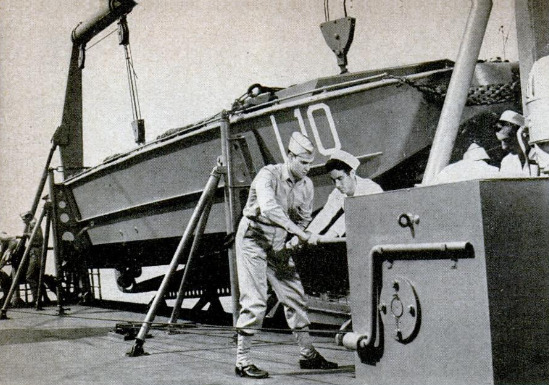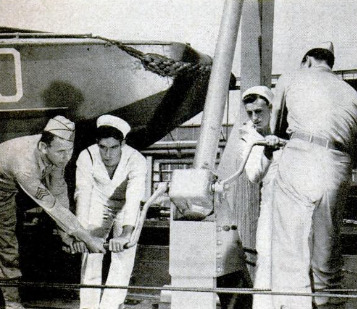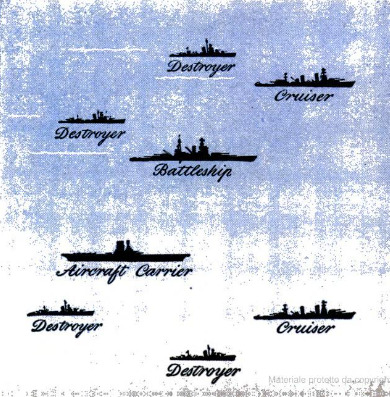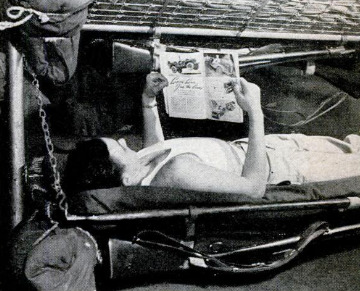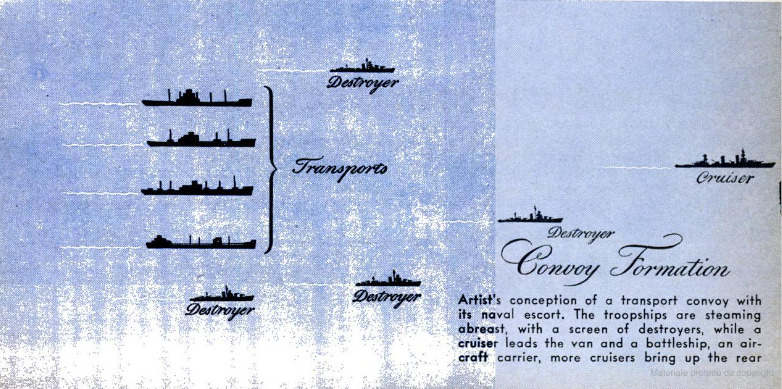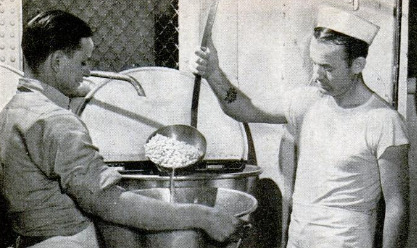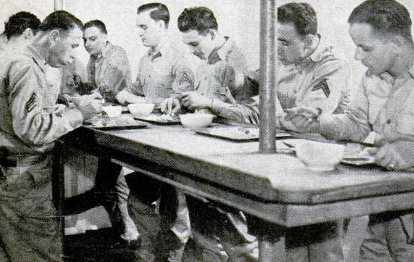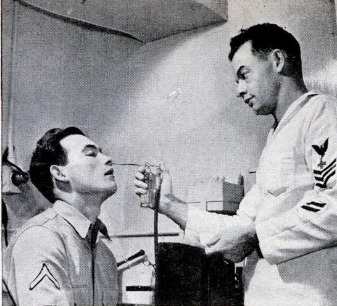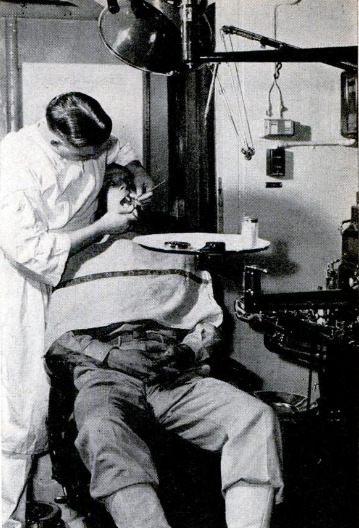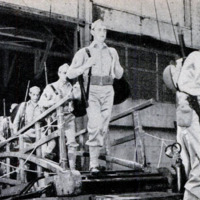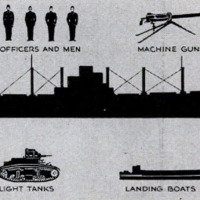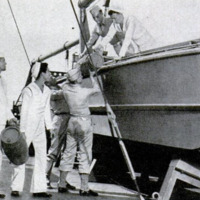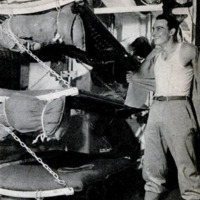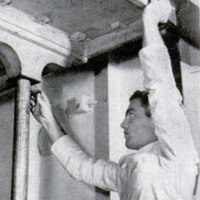-
Title (Dublin Core)
-
Modern troop transports are seagoing combat units
-
Article Title and/or Image Caption (Dublin Core)
-
Title: Modern troop transports are seagoing combat units
-
extracted text (Extract Text)
-
THE nation’s armed forces have perfected |
a new system for the sea transport of
American troops. Every troop-carrying
ship will become a fighting transport bear-
ing a self-contained combat unit, fully
equipped and with each man in fighting gear
and trim, ready to do battle the moment it is
landed. The new method, which depends
upon the fullest codperation between troops |
and crew, has been tested in simulated in-
vasion landings on American shores. |
The new transport concept differs sharp-
ly from that used by the United States in
World War I, when 2,000,000 troops were
carried across the Atlantic on American and
British troopships. Men and equipment
were dumped casually aboard the transports
then with little regard for their eventual
use.
This hastily prepared transport plan was
effective in 1917-'18, when there was ample
opportunity to unscramble the cargoes of the
vessels when they were deposited safely in
Allied ports on the other side. But it seems
obvious that the same system would not
work now.
In fact, this type of loading did not work
in World War I when Sir Ian Hamilton tried
it to land an Allied force at Gallipoli. His
troops, inadequately equipped and poorly
organized to invade an enemy-defended
shore, were forced to withdraw.
It is possible that an American force sent
on a combat mission in the present world
situation might not find a friendly shore on
which to effect a landing. Hence the new
fighting transport was devised and made
standard practice. It is simply an adapta-
tion to the sea of the land combat unit which
has been perfected.
One of the valuable American lessons of
the first World War bas been observed in
the new transport tactics, however. The re-
sult is that most transports, whatever their
load or destination, are operated by the Navy
with Naval officers in command. Whether
the troops are soldiers or marines, the Navy
is in authority while the transports are on
the high seas.
Not only are Navy officers in command,
but the transports are manned by naval
ratings. Furthermore, although there is
little chance they will ever be landed for
fighting ashore, the Naval personnel on a
transport is considered part of the vessel's
combat unit. The sailors might be used, for
instance, to operate the landing boats which
place the troops ashore.
At present there are three types of trans-
ports. The first class consists of former
Army transports which have been taken
over and are being run by the Navy as reg-
ularly commissioned Navy ships. The sec-
ond class is made up of vessels which have
been built or bought by the Navy, which op-
erates them to carry troops. The third
class consists of ships operated under Army
supervision with civilian captains and crews.
Some transports of the third class are being
taken over by the Navy.
Before the United States entered the war
against the Kaiser, the Army administered
all its own transport service. The crews
were recruited from the merchant service.
In 1917 our troopships in a submarine-in-
fested ocean were convoyed by the Navy.
Cobperation between the two branches, an
absolute prerequisite in modern war, has
eliminated possible difficulties over the prob-
lem of divided authority.
On a recent visit to a port of embarkation
some transports were on hand which had
been refitted to carry troops. The ships have
been arranged structurally to carry a com-
bat team each as an expeditionary force.
The loading is done to make each ship a
fighting transport, with each vessel carrying
a self-contained combat unit. All supplies
and equipment for this force are loaded on
each ship.
Tanks, artillery, machine guns, armored
cars, trucks and motorcycles, and other
equipment sufficient for the unit are stowed
in the holds. The troops are allotted berths
in the holds, each man having a bunk and
locker for his clothes.
These transports are veritable floating
barracks. Almost every convenience that
obtains ashore is provided on board the ship.
Large galleys or kitchens supply the food
which is served out on the cafeteria system
three times a day. Wash rooms, showers,
barber shop, canteen, tailor shop, all add to
the comfort and convenience of the men.
The health of the troops is an important
task for the doctors. On each ship there is
a large sick bay or hospital where daily sick
call is held, inoculations given, and medical
treatment provided. There is a dentist and
dentist's chair and a complete outfit of den-
tal instruments to care for the men’s teeth.
The most up-to-date system of commun-
ications is provided each ship. Radio rooms
are complete. Blinker lights, signal flags,
and hand flags are resorted to when at sea
for intership communications. Radio silence
is observed at sea for safety’s sake, for a
lurking submarine can locate a ship by radio
direction finder.
Stowed on board each ship are a number
of landing boats to be used to transport
troops to shore. Some are gasoline-engined
and others have Diesel engines for propul-
sion. They can be run up on shelving sandy
beaches and the troops unloaded. Each boat
carries a small unit of men with equipment
enough to hold a beach head. In addition
to these smaller landing boats, larger boats
are provided each transport that are capable
of carrying a light tank and landing with
it on the beach.
Let us follow a theoretical expedition of
transports to sea. The transports are loaded
and leave the dock. Before leaving the har-
bor they are joined by a naval escort of a
size depending upon the opposition to be ex-
pected. It might have one battleship, sev-
eral cruisers, six or eight destroyers, and an
airplane carrier, if air opposition is appar-
ent. The transports would be formed in line
abreast, and the speed would be that of the
slowest ship of the group. The battleship
and aircraft carrier would take station
astern of the transports, with a cruiser
ahead and on the flank. The destroyers
would encircle the ships and guard against
submarine attacks.
On being attacked by submarines, the de-
stroyers would lay depth-charge barrages.
If a transport is torpedoed and sunk, the ex-
pedition would proceed as planned, for the
unit sunk would merely reduce the force.
No essential material that would be needed
for the expedition would be lost. Of course,
the troops would be rescued by the destroy-
ers and escort vessels. This method of load-
ing the transports, by which they are self-
contained in material and equipment, not
only preserves the integrity of the expedi-
tion in case of casualty, in not losing some
particular equipment that might be essential
to the expedition, but also makes the group
flexible in that a transport can be picked out
of the group and sent off on an eccentric
mission, and be capable of landing its force
with all of their equipment.
These transports have been converted
from merchant ships, mostly cargo vessels.
An attempt has been made to make the lot
of the soldier on these transports as com-
fortable as possible, for the troops on each
ship may be forced to live on board the
transports for many weeks if not months
before being landed.
The crew of the transport and the troops
are trained to work together as a team. The
troops are available as guards, lookouts in
crow’s-nests, as crews of boats, as cooks in
the galleys, and to serve out the food. Only
the work appropriately belonging to the
sailor is performed by the crew of the ves-
sel; practically all else is performed by the
troops.
One of the most important drills is that
of bringing on deck the entire crew and the
troops to the vicinity of the boats when
danger threatens. When the alarm sounds
all hands proceed to their stations for
“abandon ship.” Booms are rigged out for
hoisting out the
landing boats, and every precaution is tak-
en to assure the safety of the personnel.
Life preservers are adjusted and life rafts
made ready to put over the side.
In the nation's defensive set-up there must
be considered our ability to land troops on
foreign soil.
Master Traffic Plans Urged
to Ease Defense Congestion
TRAFFIC CONGESTION threatens to create
a new bottleneck in the defense program,
according to Capt. C. Reynolds Weaver of
the War Department's general staff. |
“We soon will have 250,000 military mo- |
tor vehicles on the nation's highways,”
Captain Weaver explains. “They range in
size from the quarter-ton jeeps to 7ls-ton
trucks and even larger units, What happens
when trafic control fails during military
operations has been demonstrated tragical-
ly in France.” |
One way of breaking this potential bottle-
neck, Captain Weaver points out, is through
master trafic plans developed by many
cities and communities. Cooperation be-
tween military and civilian authorities can |
prevent conflicts between convoys and ci-
vilian traffic and relieve congestion around
key industrial plants and on important |
routes.
-
Language (Dublin Core)
-
Eng
-
Date Issued (Dublin Core)
-
1941-12
-
pages (Bibliographic Ontology)
-
81-85,220
-
Rights (Dublin Core)
-
Public domain
-
Archived by (Dublin Core)
-
Sami Akbiyik
 Popular Science Monthly, v. 139, n. 6, 1941
Popular Science Monthly, v. 139, n. 6, 1941



